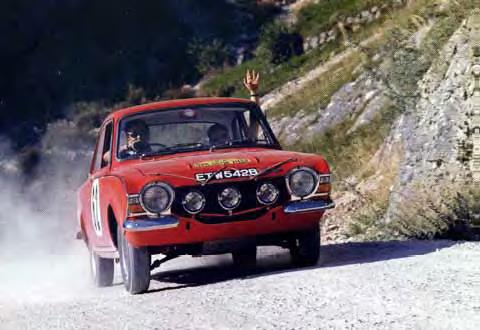There is a great article in this months Historic Car Register Newsletter (Northants and Bedford area) which we have reproduced with the kind permission of Andrew Bodman.
The Liège Rally
from Andrew Bodman
The Royal Motor Union of Liège used to organise the Marathon de la Route, to give it its official title. It was also known as the Liège-Rome-Liège Rally, which ran between 1931 and 1960. For the next four years it became the Liège-Sofia- Liège Rally, as the route turning point was relocated to Bulgaria. Commentators described it as a very well organised and run rally.
It was also considered to be the toughest round of the European Rally Championship, which was the top rally series prior to the introduction of the World Rally Championship in 1973.
During the last five years of its existence, the average number of finishers was 16, with a low of 8 in 1961, from an average number of 97 starters. This was a seriously high rate of attrition. It was reported that Maurice Garot, the clerk of the course, considered that, ideally, there should be just one finisher. He never quite achieved his aim although he got close.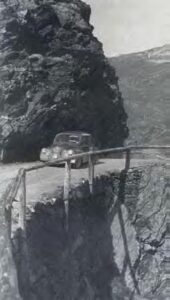
Picture right 1953 A Renault 750 ascends the Gavia pass. The drops are much deeper than shown in this photo, and the only protection here is a wooden rail. Elsewhere on this pass there was even less protection. (Photo credit McKlein)
So, what made the event so tough? There were many factors which I will endeavour to explain. The route usually covered 3,200 miles or more, making it the longest round of the championship. There would generally be one hour of rest at the halfway point and other than that, the driving was non-stop for 92 hours (four days). “Wakey-Wakey” pills (Benzedrine) were taken by many competitors to stay awake, and to achieve a competitive result the codriver needed to be a seriously good driver as well to share the load with the driver. Some team managers paired two drivers in the same car: for example Roger Clark/Brian Culcheth in a Rover 2000 and also Peter Procter/Peter Harper in a Ford Mustang both in 1964. The lack of sleep caused mistakes to be made by extremely tired crew members, whether that was drivers leaving the road or codrivers making navigational errors.
Here are two examples of tiredness/exhaustion on this event. Tony Ambrose was reading pace notes to Rauno Aaltonen after leaving Sofia on the ’64 event and then the notes stopped coming. Tony had fallen asleep exhausted. Rauno slipped a pillow between Tony’s helmet and the rollover bar to stop his head from banging into it, and he also roped Tony’s chest to the rollover bar to stop him from being thrown forward in the event of a sudden stop. Presumably the Healey 3000 did not have seat belts. In 1962 Paddy Hopkirk, also in a Healey 3000, had a problem with a broken rear spring, which was trying to work its way into the cockpit beneath his seat. Paddy admitted afterwards that he was praying that the mechanics would not be able to repair his car as he was so desperately tired.
Picture left 1961 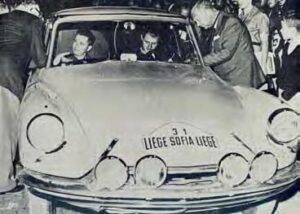 Winners Lucien Bianchi/George Harris Citroën DS19. A rare success for this marque, in the year that there were only eight finishers. Photo credit Autosport
Winners Lucien Bianchi/George Harris Citroën DS19. A rare success for this marque, in the year that there were only eight finishers. Photo credit Autosport
The average speeds, set by the organisers for each section, were created to make the event “acceptable” to the authorities of the countries through which the rally passed. But they bore little relation to reality. Graham Robson explains the system well in the “History of Rallying”. “The organisers introduced whimsical timing methods which demanded great intelligence and foresight from codrivers and team managers. The cunning system they introduced, theoretically allowed a sensible average speed between individual controls; the Road Book, however, also specified a precise period during which each control was open to a particular competitor. As the event progressed these periods were moved gradually and persistently forward in relation to the theoretical average speed. This meant that a complacent (and unsuspecting) competitor, content merely to achieve target times, would eventually arrive at some control in the depths of Yugoslavia to find it closed, and the officials on their way back to Belgium. Indeed, had he persisted at th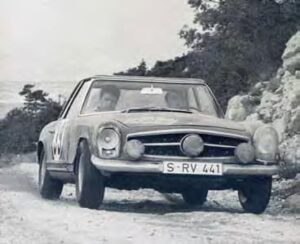 is rate, he would have arrived back at Liège 24 hours after the winner had received his garlands!”
is rate, he would have arrived back at Liège 24 hours after the winner had received his garlands!”
Picture right 1963 Winners Eugen Böhringer/Klaus Kaiser Mercedes-Benz 230 SL, which had only been launched at the Geneva show that year. Eugen also won the previous year in a Mercedes-Benz 220SE. Photo credit Autosport
The Italian authorities, having become familiar with the rate at which Liège competitors travelled through their country, requested that the rally organisers slowed down the competitors in some parts of Italy. The Royal Motor Union of Liège obliged; by setting minimum times (equating to average speeds significantly less than 50 kph) over road sections between timed climbs of the great passes. However, the overall average across the combined road sections and climbs (such as the Croce Domini, Vivione, Gavia and Stelvio) remained at 50 kph. That had the effect of upping the average speed required on each of the timed climbs.
It should be remembered that in those days most of the mountain passes would have been unsurfaced narrow “roads” with no armco barriers and major drops over the edge. Yugoslav “roads” will be discussed later.
The maximum permitted lateness for each competing crew started as 1 hour and gradually increased until it became 3 hours when crews reached Yugoslavia. It remained at that level through Yugoslavia and Bulgaria. Shortly before crews left Yugoslavia, the maximum lateness was gradually wound back in 15 minute increments, so that by the time crews reached the final night in Italy the maximum permitted lateness had returned to one hour. So imagine being say two and a half hours into your maximum lateness when you leave Yugoslavia; you not only have to keep up with the organisers high average speeds, you also need to gain one and half hours on the schedule in the course of approximately 12 hours driving to avoid exclusion, with, in all likelihood, a car that was no longer at its best. Ideally competitors would try and stay as close as possible to their earliest reporting time at each control. It should be noted that the earliest and latest reporting times for each control had been handwritten (!) onto the competitors’ carnet de passage (time card book) before they were first issued.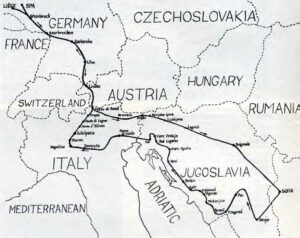
The petrol available in several of the countries traversed was of poor quality so it was essential to fill up with “Super”. There might however be only one Super pump in a petrol station and competitors could not afford to wait in a queue. So works service crews would transport their own petrol and hand pump it into their competing cars.
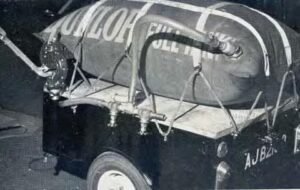
Picture Right 1964—BMC’s Mk 3 refuelling rig for supplying petrol to their team cars. It was towed behind their service barges, and had a capacity of 100 gallons.
Service crews were spread very thinly due to the extremely large distances involved. Service points were usually situated (by BMC) just after time controls. In some places there might be just one individual deposited in a remote village with a pile of new tyres (mounted on wheels), some petrol and tools. He might be left there for a day or more.
Picture Below 1964 At approximately 10:07pm we have a Mercedes-Benz 300SE, a Humber Sceptre and a Ford Cortina GT lined up across the main street in Spa. They were all to be released on the same minute, but Henry Taylor/Brian Melia are a bit more eager to get started in their Cortina. Photo credit McKlein
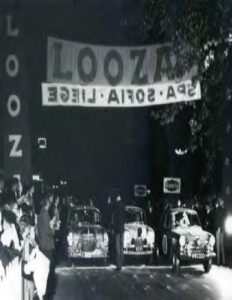
There were many other causes of delays, which competitors had to deal with whilst trying to achieve the organisers’ (real) time schedule. The rally usually ran between the evening of the last Wednesday in August and the evening of the last Sunday in August. Therefore, there was extra holiday traffic particularly on the return run to Belgium. There were often accidents between noncompeting cars on major roads which caused significant delays. There would be up to ten border crossings between countries subject to the whims (and delays) of local officials. There was no Schengen group of countries in those days. There could be road works, closed level crossings and crews were sometimes held up while blasting took place in quarries close to the road. Some competitors in sports cars such as MGAs and Porsches discovered they could get over the level crossings before the trains arrived by lifting the barrier slightly. The organisers themselves sometimes introduced lengthy diversions and additional time was not always granted for these.
Marcus Chambers (BMC Competitions Manager 1955-61) reported in his book “Seven Year Twitch” that Austin A50 crew John Gott/Bill Shepherd had driven for 25 hours without eating on the ’55 Liège, as they found the time allowances were so challenging even though their car had a “Le Mans” engine. Marcus learnt from this, and in future years endeavoured to provide food and drinks at some service points on the Liège. Competitors also had to travel quickly enough to generate time for service work and, even then, it would usually be very brief.
One of the quirks of the event was the manner in which cars were started. The real start of the rally was in the town of Spa some 6 miles from Liege. Cars were lined up three abreast across the road and started simultaneously. Three minutes later the process was repeated.
The organisers’ route instructions consisted of a list of controls, so no tulip diagrams to assist; the maps available, particularly for Yugoslavia were of poor quality. With a frequent absence of signposts in remote areas, navigational skills were at a premium. Some of the works crews did carry out reconnaissance runs when they made pace notes and/or navigational instructions.
Maurice Garot first included Yugoslavia in the Liège route in ’56. In the following years, the mileage used in this country increased and the roads chosen became more challenging— narrow, extremely rough, twisty, very dusty and mountainous. Competitors were known to unfavourably compare some sections with goat tracks. The most challenging sections in this country were usually included after the mid-rally “rest” point. The average speed set might well be between 60 and 70 kph. These rough sections caused many mechanical failures, multiple punctures and caused numerous crews to go over their maximum lateness. In 1960 the time spread separating the top 10 crews going into Yugoslavia was 2 minutes 50 seconds. On leaving this country, the top 10 spread had increased to 36 minutes. In 1961, the year of the fewest finishers, Yugoslavia had a dramatic effect on the number of competitors: 76 cars went into the country but only 12 cars were running when they left Yugoslavia.
Tough cars were needed to win this event. Between ’55 and ’64 Mercedes-Benz won four times (300SL twice, 220SE and 230SL) while Austin Healey 3000 and Porsche 356 Carrera both won twice. Citroën DS19 and ID19 models were entered many times from ’59 onwards. Some ran with light weight body panels (fibreglass or aluminium) and gained the lead several times through their performances on the roughest sections in Yugoslavia. Unfortunately, they were let down on occasions by suspension or gearbox problems and, consequently, took only one outright win.
Rover, perhaps trying to change their image, entered a team of (largely showroom specification) 3 litres in ’62 and ’63 and 2000s in ’64; they managed to bring two of their cars to the finish at the first two attempts but no 2000s made it to the finish in ’64. Rules on homologation were considerably more relaxed on the Liège. So, for instance, two Morris 1100s were entered in 1962 just two weeks after the model had been launched; neither finished although the new Hydrolastic suspension was not the cause of the retirements. Ford entered two Corsairs with Lotus twin cam engines in ’64 although such a car was never put into production.
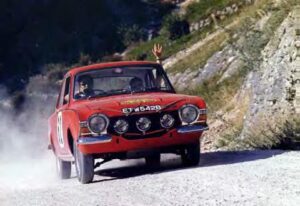
Picture Left 1964—David Seigle-Morris/Tony Nash, Ford Corsair Twin Cam prototype. Retired in Bulgaria due to an accident.
There were some notable achievements amongst some of the smaller-engined cars. When there were only eight finishers in ’61, one of those was an Anglia 105E driven by a privateer Belgian crew—a very tenacious performance. Perhaps even more creditable was another Belgian crew bringing their Daf Daffodil (750cc, Variomatic transmission) to the finish in ’63.
Getting permission to pass through some of the intended countries for the ’65 rally proved to be impossible. So, the event was reformatted into an 84-hour endurance race at the Nurburgring.
The ’70 London Mexico World Cup Rally held its first two Primes (stages) in Yugoslavia which was a nod of the rigours of earlier Liège rallies. The first Prime ran from Titograd to Kotor and the second from Glamoc to Bos Krupa.
Next month I plan to provide a synopsis of the trials and tribulations of John Wadsworth/Mike Wood on the ’64 event. They drove the only Mini (Cooper S) to finish any of the Liège rallies.
Andrew
(Of course if you want to read Mike Wood’s memories of the event his book is now available for the a mere £8.00. Ring Mike on 01282 771563 for full details.)

